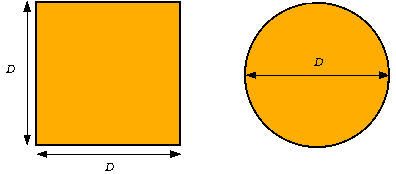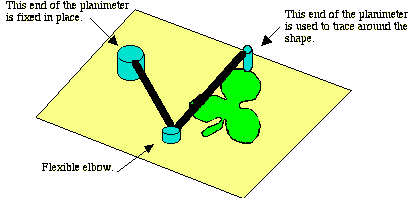Green's Theorem
and the Planimeter
Part 4: Experiments with the Planimeter
The following applet simulates the operation
of an area-measuring instrument called a planimeter. First chose a region
in the menu to the left by clicking onto it. Then move the end of the planimeter
to the starting place and drag along the curve counter-clockwise until you make
a complete loop. The planimeter starts measuring when you pass the starting place
the first time and stops when you reach it again.
A planimeter usually consists of
two metal arms joined by a flexible elbow. One end is fixed in place, while
the other end with the wheel on it) can be moved around on the plane. This device
is operated by using the wheel to trace around shapes on the plane.
The wheel either rotates or slides,
depending on how it is being moved around the shape in the plane. The device
records the number of revolutions that the wheel made as it was traced around
the shape in the plane. You can find more about the operation of planimeters
by clicking here.
- Two of the shapes that are available
for tracing with the planimeter are a circle and a square. The sizes of these
shapes have been chosen so that the length of each side of the square is precisely
equal to the diameter of the circle (see below).

Predict what the ratio of the
area of the circle to the area of the square will be.
- Use the planimeter applet to
trace around the circle and the square. Record your results.
- What is the ratio of your results
from the planimeter? What property of the circle and square do you think the
planimeter actually measures?
- Use your results for the circle
and square to find an equation for converting the results from the planimeter
to the actual values of the properties of the shapes traced by the planimeter.
- Use the remaining shapes to check
the conversion equation that you found above.


